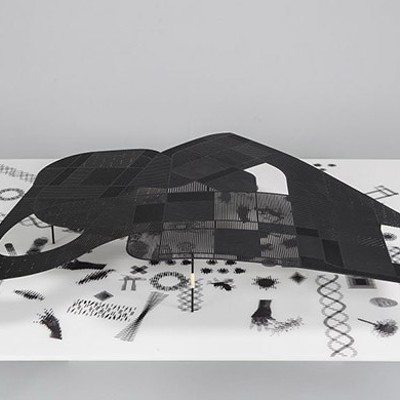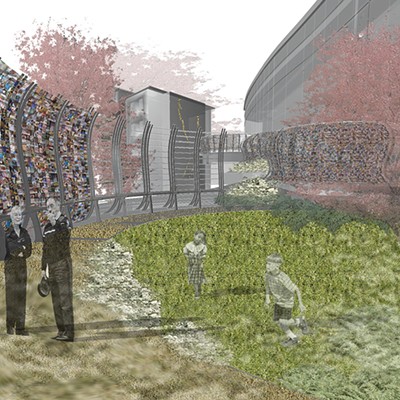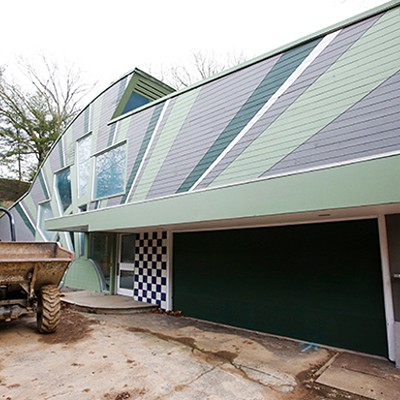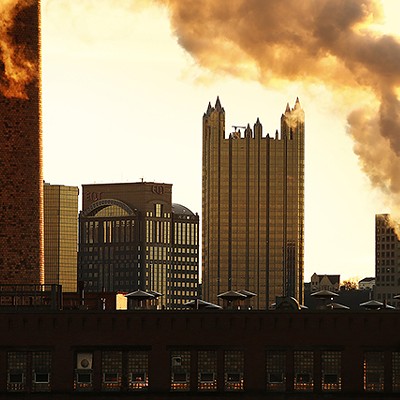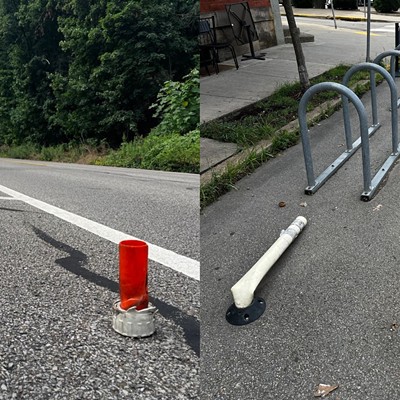"What's a French curve?" my friend the writer asked as I tried to explain the 30-foot-long flat thing in the middle of the Krause Campo. Situated on the roof of the one-story Posner Center, the new garden space and permanent art installation is located behind the College of Fine Arts at Carnegie Mellon University (where I am an adjunct faculty member).
A French curve is either an irregular "S" with one lobe too many, or perhaps a very stylish amoeba: Much smaller versions are used to draw curved lines the way a ruler is used for straight ones. They've fallen out of frequent use today, but in the days before computer drafting, designers and artists used them routinely. You just have to go back a few years to find them.
Then again, reversing time, as well as entrenched expectations, is a consistent theme of this piece, created by conceptual artist Mel Bochner and landscape architect Michael Van Valkenberg. To reinforce this notion, a quotation about the nature of time on the north wall of the space, from Ludwig Wittgenstein, is actually written backward.
This feature is an appropriate threshold for the space, because from this point, you either go along with the piece -- physically and intellectually -- or you don't.
You could get on the meandering network of pathways, paved in a saturated, traffic-cone orange, and wander away from and then back toward the big French curve, but not really arrive anywhere else. You could wonder at the surface of this oversized drafting instrument, with its grid of roughly 8-inch-square single digits selected and oriented at random. You could sit on the French curve or even sunbathe, as students did when the weather was good. Or you could just get on the straight, regular sidewalk and bypass the whole thing.
I have to admit that at first, I thought the backward quote was sort of glib. Reverse time by reversing the words. Get it? Then I actually read it both frontwards and backwards a few times -- hey, which is which? "In walk they direction the changed have people ..." it begins. The backward orientation doesn't simply reverse the meaning of the quote; it makes the reader ruminate on how sequence and order create meaning. (It also, not incidentally, pokes fun at the profusion of high-minded inscriptions on college campuses and elsewhere.)
Visitors should also visit the Miller Gallery at CMU for an exhibit in which Bochner's work especially reinforces this idea. "We hope our design offers all of the pleasures of a garden, including intellectual stimulation," the designers have written. That intellectual engagement is key. The pleasure of their work comes not at a glance, but from the willful effort to think its elements through.
Within this mandate, other elements of the piece are clearer in their broader exploration of reversals and inversions. The French curve is actually hilarious, in a conceptual sort of way. Curved undulating forms in the landscape are supposed to make us think of nature, but here, instead, they give us the expression of human artifice. The tool becomes the artwork. The grid, which is supposed to be an emblem of rationalism, is articulated here with a completely random and arbitrary positioning of numbers, another inversion. Bochner says that he was inspired by the mosaics in ancient Roman floors at Pompeii and Herculaneum. Of course, he transforms visually pleasing motifs into something intellectual and oddly de-aestheticized -- putting the "mental" back in ornamental.
The more I think about this piece, the more rich and entertaining it seems. Actually, the designers assert happily that the pathways themselves aren't for going anywhere; they are intended to inspire contemplation and intellectual investigation. "Why the hell are these orange, anyway?" Precisely because a conventional pathway is a background element from which more important designed features are to be viewed.
Another friend, an artist, found the pathways ugly. But the expressed intention of this landscape is to undermine and recalibrate traditional aesthetic notions and approaches rather than to revel in convention.
Beautiful not is it as ugly much so not is it.


